





Wiktionary defines triternate as: Three times ternate; applied to a leaf whose petiole separates into three branches, each of which divides into three parts which each bear three leaflets.
Let's see what that means. Now, a ternate leaf is one that is divided into three leaflets.
In biternate leaves each of these three leaflets is further subdivided into three, making 9.
In triternate leaves this tripling continues, each of those leaflets divide into three, so 27 leaflets are in each leaf.
Now what does that actually look like?
Biternate Aquilegia Leaves |
||
|
Aquilegia flabellata is a tiny alpine plant with 'fan-like'
leaves close to the ground. I have here one single leaf. |
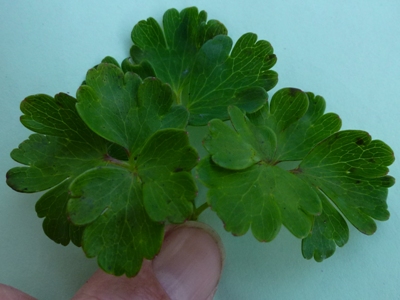 |
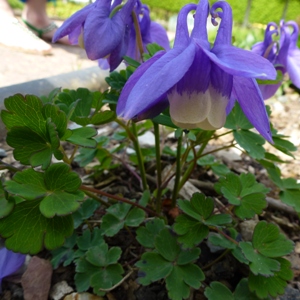 |
| Let's look closer at that leaf. The petiole (leaf stem) divides into three (I've pulled one of these off to clarify). Then each of those three has a further division into three, making a total of 9 leaflets in this one leaf. This is a biternate leaf. |
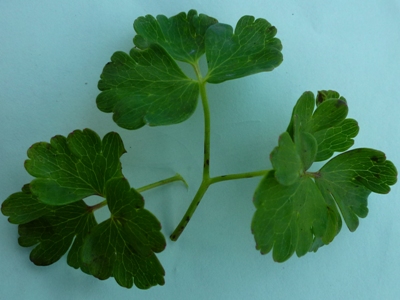 |
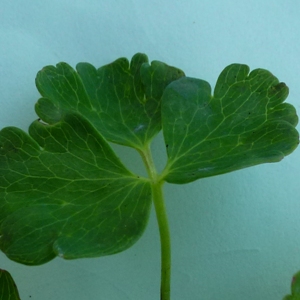 |
| Let's see another example: | ||
|
Isn't that a pretty leaf? This hybrid aquilegia has very
different leaves to the above. Each leaflet is very 'frilly', or 'deeply incised', rather than rounded, which is highlighted further by the red edging. My fingers hide the first division into 3, which the 2nd photo shows after I've pulled the first three divisions apart. So different species (including the American ones), may normally look like this. |
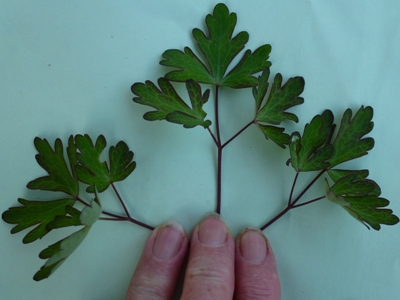 |
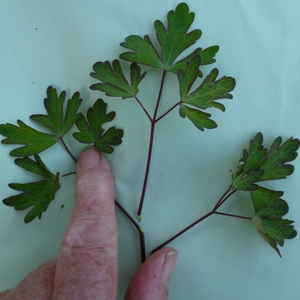 |
| These show the deep insisions that the leaf makes, delving deep into the lamina, but not (mostly) making it, so there are 9 leaflets here. (OK, some incisions come back to the stem, see top leaflet rhs above my finger, but I don't think this quite makes an extra division that is necessary for defining triternate leaves.). |
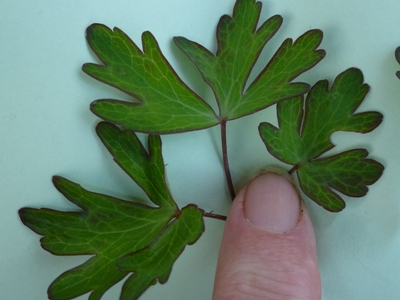 |
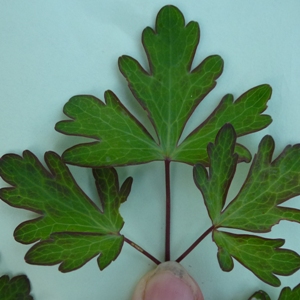 |
| Interestingly, this leaflet above, due to the three main
deep incisions, plus all the other deep incisions within the
leaflet makes the leaf look more triternate than many triternate
leaves! As a rule of thumb, triternate leaves look more maidenhair-ferny leaved than usual aquilegia leaves. Right hand side (RHS photo is of a hardy maidenhair fern) |
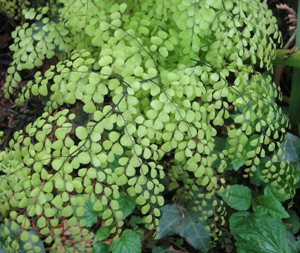 |
|
Triternate Aquilegia Leaves |
||
| This is one aquilegia leaf, each
petiole comes from ground level, from the 'nose' or very short
shoot that grows close to the soil surface. Far right, the photo shows the first ternation: division of the petiole into 3. |
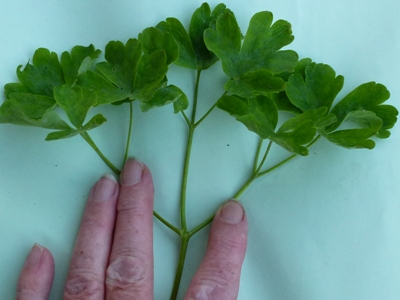 |
|
| I have pulled the three main divisions apart, hopefully to
clarify the make up into a further 3 divisions. Far right, the photo shows one of the 3 second ternations: division again into 3. |
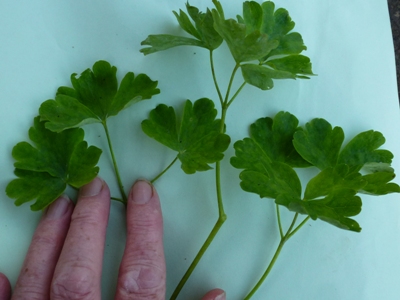 |
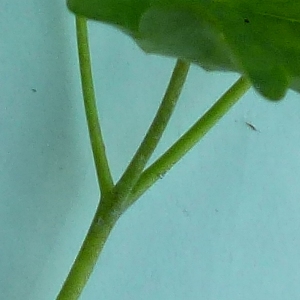 |
| So this is one third of the whole leaf, clearly divided into
three. Each of its leaflets is further divided into three, so this whole leaf is triternate. Yeah, ok, the leaflet I am holding doesn't quite manage the division of its lamina (leaf surface) right down to its stem, but the far right photo hopefully clarifies that the other 2 leaflets do divide into three.... just! |
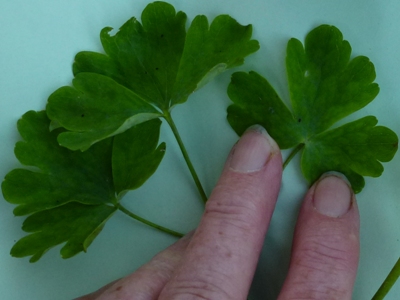 |
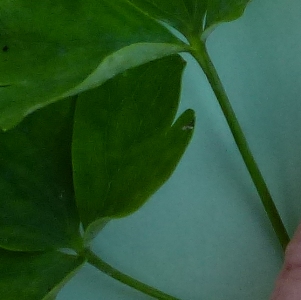 |
| Another example: | ||
| Nice dark leaf-stem (petiole) here. Divides into three. |
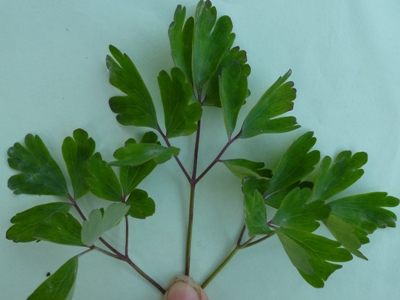 |
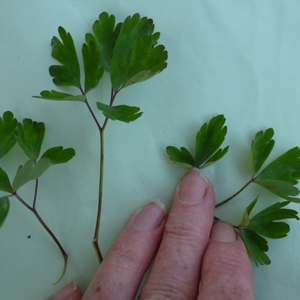 |
| Each three divides, and those leaflets also divide into
three again. Triternate. Far right, the uppermost leaflet has only just divided into 3, the two leaflets either side have not only divided into three, but the lower two are staggered at different places along the (by now, thrice-divided) petiole. |
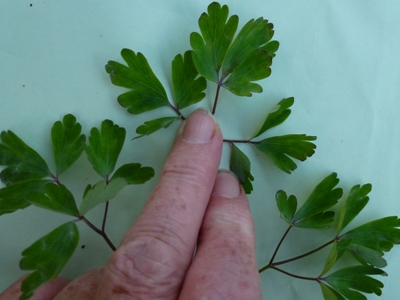 |
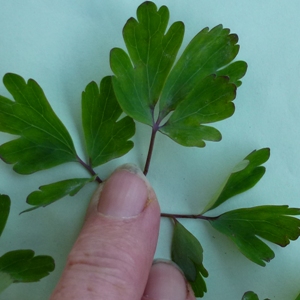 |
Recap: biternate and triternate |
||
| Here are the 4 examples above, altogether, so you can also
appreciate the relative sizes and colour shades. The main photo is of one third of each leaf, and the smaller photo (on the right) one ninth of each leaf. In that smaller photo, the two on the left are not actually divided further, although the red-edged one looks rather as if it does so. |
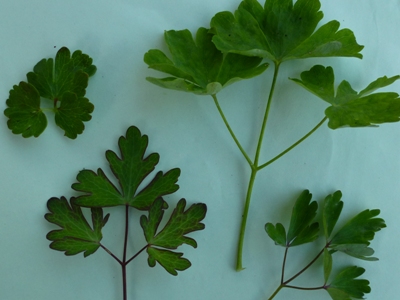 |
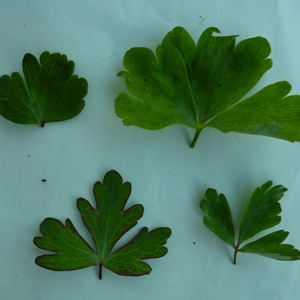 |
Leaf effects of Downy Mildew infection |
||
| Let's delve a little further looking at
normal (uninfected) leaves.
Here's a third-piece of 2 other aquilegia leaves. The lighter
colour of the left leaf is because it is from a white-flowered
aquilegia. It is triternate, seen more clearly on the RHS photo. The darker leaf is biternate (although there is a tendency towards a further division as both side leaflets have a lower lobe that has actually separated). |
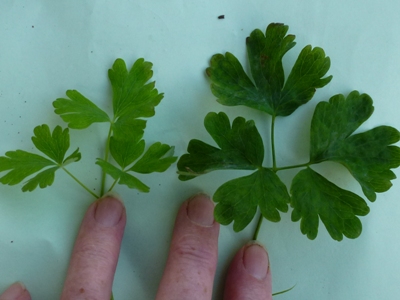 |
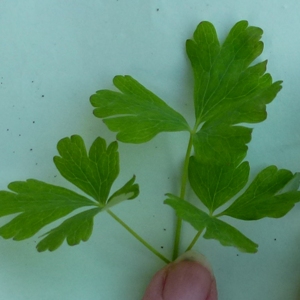 |
| See how the terminal leaflet is divided into three in the lighter, triternate, leaf but not the darker, biternate, one? |
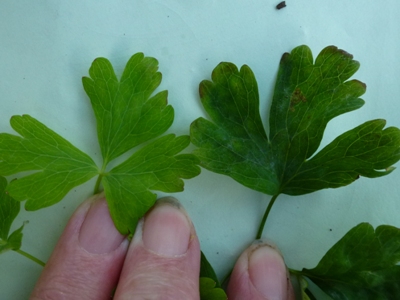 |
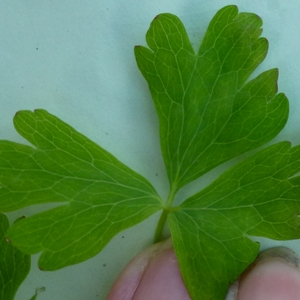 |
| Now let's see what downy mildew can do to a leaf. | This is a systemically leaf that is infected as soon as it grows,
rather than afterwards (where it shows as yellowy angular
patches). These infected leaves are lighter / whiter green compared to normal, with an upright habit, and with long leaf petioles compared to leaf lamina. The lamina is often curled (upwards or downwards). |
|
| The leaf on the left has downy mildew infection, it is very
slightly lighter-coloured that the leaf of the white-flowered
aquilegia (which featured in the 4 photos above). Do you agree it looks more 'maidenhair-ferny'? Note the infected leaf is the whole leaf, the white one is just a third of a leaf (in far right photo, we compare like with like, a third of a leaf each). |
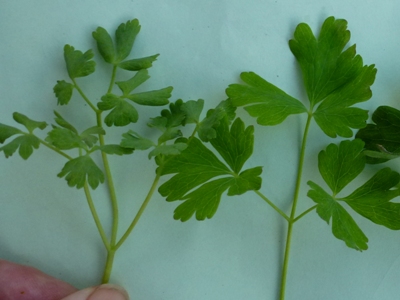 |
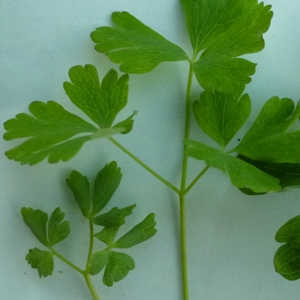 |
| Both of these are triternate leaves, but, I think that
because the leaf surface area is smaller, and curled, it looks
more finely divided than it actually is, botanically. More like maidenhair fern, yes? |
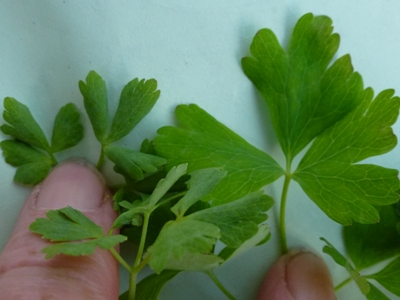 |
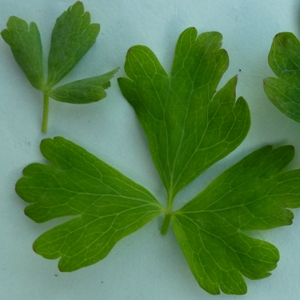 |
| Link to page about plants infected in this way. | What do you think? Do you agree with me? How would you describe the changes that downy mildew makes? | |
| Back to top |
Copyright Carrie Thomas 2014. Web wizardry by Trevor Rees. All rights reserved.